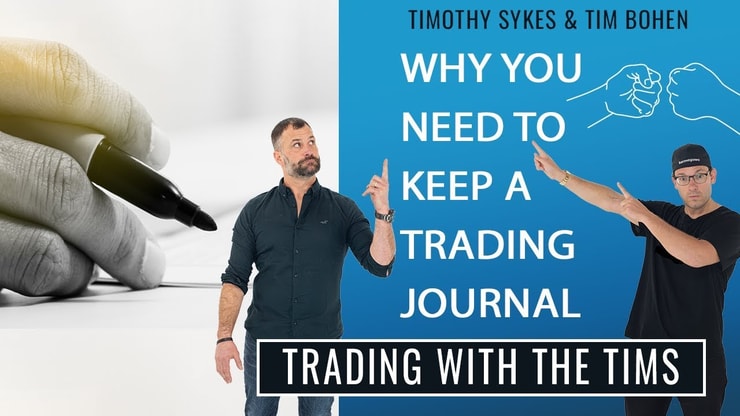What’s the best way to approach intraday trading? It depends on your trading style…
Intraday trading — also known as day trading — can be one of the most rewarding ways to trade in the stock market. It can also be one of the most dangerous.
New traders often wonder if intraday trading is right for them. I’ve been a day trader for 20+ years and have made over $7 million in trading profits in my career.* And I started trading with a small account. That’s what I teach my Trading Challenge students now.
So is intraday trading right for you? That depends.
Read on as I go over the pros and cons of intraday trading. I’ll also give you some tips on intraday trading for beginners, and strategies to help you decide if it’s your thing.
Table of Contents
- 1 What Is Intraday Trading?
- 2 Is Intraday Trading Profitable?
- 3 Pros and Cons of Intraday Trading
- 4 Is Intraday Trading Good for Beginners?
- 5 Intraday Trading Tips and Strategies
- 6 The 3 Most Accurate Intraday Trading Indicators
- 7 How to Select the Right Stocks for Intraday Trading
- 8 Frequently Asked Questions About Intraday Trading
- 9 The Bottom Line: How Can You Make Money in Intraday Trading?
What Is Intraday Trading?
Intraday means within a single day. So intraday trading is buying and selling a stock on the same trading day.
You’ll also hear about intraday highs and lows. That’s a stock’s high and low prices within a trading session. Day traders and swing traders use intraday highs and lows to measure a stock’s performance.
As a day trader, I wait for stocks to hit intraday highs to let me know that buyers are in control. I’m also watching for stocks to fall to intraday lows to see if sellers are in control.
Learning how to use Level 2 quotes can help you understand why stocks rise and fall the way they do. Check out my “Learn Level 2” DVD for more on this.
Is Intraday Trading Profitable?

2025 Millionaire Media, LLCThis is probably the question I get most often. New traders want to get into intraday trading because they want easy money. That’s not how it works. Day trading takes hard work and dedication … just like anything worthwhile in life.
Intraday trading can be profitable … I wouldn’t be teaching about it if it weren’t. I want people to understand the great opportunity in trading momentum stocks. I’ve seen stocks jump as much as 1,000% in a single day. That’s a huge opportunity even if you only catch a piece of the move.
On the flip side, day trading can be very risky. So make sure to be meticulous, and go in prepared.
Don’t expect to make millions right away or ever. Trading is hard. Remember, it’s a marathon, not a sprint.
Pros and Cons of Intraday Trading
Let’s break down some of the top advantages and disadvantages of intraday trading…
Pros
- Potential for a faster learning process. You’re placing more trades than you would with a longer-term strategy, and you’re following the markets like a hawk … at least you should be. You can get daily exposure to the stock market.
- Avoiding overnight risk. This is a big advantage to intraday trading, especially with penny stocks. I can’t count how many times I’ve seen a penny stock company announce an offering after hours — diluting the shares and screwing everyone who held overnight. Day traders don’t have to worry about that. They focus on taking the meat of the move during the day.
Cons
- Losses can add up quickly. There’s always a chance of getting stuck in a trade due to illiquidity or a trading halt. That’s why you choose your trades carefully. I have seven indicators I check for every trade.
- You can lose all your money in a short time. This is probably the biggest concern with day trading. It’s why it pays to be meticulous. A big part of what I teach is how to control losses … I think the best traders play defense first. In trading, like in sports, defense wins championships.
Is Intraday Trading Good for Beginners?

2025 Millionaire Media, LLCIntraday trading can be good for beginners who are willing to pace themselves and work hard. And I mean hard. If someone comes in expecting to make thousands of dollars on day one, the market will teach them a lesson or two.
Day trading takes time to master. I’ve been trading for 20+ years, and I still have to study and adapt every single day.
If you’re a beginner, start with small positions as you learn patterns and find your trading strategy. Sizing up too quickly is a recipe for disaster. If you’re someone that’ll size up too quickly, day trading might not be the best place for you. Day trading is all about patience and grit.
More Breaking News
Intraday Trading Rules: Guide for Beginners
Now let’s go over some intraday trading rules to help you keep your head in the face of volatility…
Cut Losses Quickly
This is rule #1. Always cut losses quickly. Never overstay in a position that goes against your trading plan.
If I’m in a trade and feel even the slightest uncertainty, I get out. I don’t see a reason to risk my hard-earned cash when I can find another trade. I don’t understand why so many traders fall in love with the stocks they trade. Don’t marry stocks — trade them.
All you have to remember is three words: Cut losses quickly!
Don’t Overtrade
Trading can be like an addiction and lead to overtrading. If you find yourself overtrading, the best thing to do is step away r. Don’t come back until you can get a handle on your emotions.
Overtrading happens for all sorts of reasons. As an overtrader myself, I’m pretty good at teaching how to avoid it. That’s because I understand the reasons I do it.
One of the most dangerous reasons is revenge trading. For some reason, humans have a hard time accepting losses … After a loss, traders can hop into another trade to try to make up for the one that went wrong. This usually results in an even bigger loss. Don’t do it.
Do whatever you can to avoid overtrading.
Intraday Trading Tips and Strategies
Let’s get into some more specific tips and strategies for day trading…
Trade Momentum Stocks and Big Percent Gainers
When I look for stocks with the potential for big gains, I look for momentum stocks. They have millions of shares traded and are up big on the day.
How do I find them? I use a stock screener to scan for the biggest percent gainers. They’re often the stocks with the highest volume, catalyst, and liquidity.
My go-to stock screener is StocksToTrade. It has killer charts, customizable scans, access to Level 2, and more. Check it out for yourself. Grab a 14-day trial for just $7!
(For the record, I proudly helped design and develop StocksToTrade and am an investor in it.)
Follow the News
News acts as a major catalyst for stocks. Good news can send a penny stock soaring, and bad news can make it tank. But how do you know which news items have the potential to move a stock?
StocksToTrade’s Breaking News Chat add-on can help you keep up with the news that matters to traders. Two market pros sift through all the news and alert the top items that have the potential to supercharge stock moves. It’s changed my trading since its release last year. Get a 14-day trial of StocksToTrade and the Breaking News Chat add-on and see what game-changer this is.
Focus on Morning and Afternoon Trading
You’ll find the most volume and volatility right after the market open and just before the close.
Go where the action is. To me, that means watching the market at the open and the close. Be prepared for fast action and to pounce on some of the hottest trading opportunities.
Keep a Trading Journal
This is crucial for traders. How do you know what’s working if you don’t track it? I don’t care how long you’ve been trading,
You can use your trading journal to record all your trades, why you chose them, how you felt, and what you learned. Keeping a trading journal can help speed up your learning process so you can find the strategy that works best for you.
The 3 Most Accurate Intraday Trading Indicators
The sheer number of patterns and indicators can be overwhelming for a beginning trader. Below are three of the most accurate intraday trading indicators … You can focus on them while you’re learning.
Breakouts
Breakouts are a great indicator that buyers are in control. Anytime a stock breaks a previous high, lots of traders buy in, which can push the price even higher.
A breakout can also create a short squeeze when short sellers are forced to buy to cover.
Watch for breakouts — and remember to cut losses quickly if the stock starts going against your plan.
Volume-Weighted Average Price (VWAP)
VWAP is a benchmark for afternoon trading. It’s a great way to see where a stock’s traded intraday based on volume and price.
This indicator has become popular in recent years and is now an irreplaceable tool for many traders. I may look for afternoon opportunities when a stock is trading above VWAP. It can also act as a support level and stop-loss point if you’re in a trade that goes against your trading plan.
Relative Strength Index (RSI)
RSI uses an index scoring from 0 to 100 based on momentum in a stock’s highs and lows. Typically, a reading of 70 or higher indicates a high point, and 30 or lower indicates a low point.
Traders use RSI to see if there are higher lows or lower highs. If you see lower highs, be aware of a downtrend. Higher lows are usually a bullish sign.
RSI can be a good short-term indicator.
How to Select the Right Stocks for Intraday Trading
There’s a lot of gray area when it comes to day trading, and that’s why you must do your due diligence. Finding a solid mentor who can show you the ropes is a great way to get started.
I started the Trading Challenge for that reason. I want to be the mentor I never had when I was starting.
The Challenge gives you access to tons of video lessons, live webinars, arguably the best trading chat room around, and more. Everything included in the Challenge is for the sole purpose of helping you improve as a trader.
But discipline isn’t something I can instill in you. You have to be willing to do what it takes to make it in the market. Are you up to the Challenge? If you’re ready to work your butt off, apply to the Trading Challenge today and find out if you make the cut!
Frequently Asked Questions About Intraday Trading
What Is the Best Time Frame for Intraday Trading?
I know traders who like the one-day chart to find the primary trend and the five-minute chart for the short term. I think it’s good to look at a variety of time frames. That way, you can see the primary trend, gauge whether there’s resistance and support, and find a good target price.
How to Use Pivot Point in Intraday Trading
The pivot point averages a stock’s high, low, and closing prices from the previous trading day. If the price is higher than the pivot point, it points toward a bullish bias. If the stock is below the pivot point, it points to a bearish trend.
Which Stocks Are Best for Intraday Trading?
I like high-volume, momentum penny stocks. They usually come with the best opportunities. With their relatively low float, an increase in volume can cause big, fast moves. I aim to take the meat of the move and move on. I prefer the volatility and potential in penny stocks over slow-moving large-cap stocks.
The Bottom Line: How Can You Make Money in Intraday Trading?

2025 Millionaire Media, LLCNothing in the markets is easy or guaranteed. You have to work at it. I’ve made over $7 million day trading penny stocks in my 20+ years of trading.* I’ve worked with many students who have gone on to hit big milestones (see my latest breakdown here).*
It takes years of dedication and discipline to learn how the market works. And most traders fail. I think that’s because they fail to prepare.
So before diving into intraday trading, understand what to look for in a setup. Know which indicators work for you. Trading is not an exact science. Always cut your losses quickly, and avoid overtrading. The best traders always play defense first!
If you’re dedicated to learning intraday trading, apply to the Trading Challenge. I share all my trades and process every day in the chat room.
And finally … Never assume the market owes you anything. The moment you start thinking that, the market will humble you fast.
What do you think? Is intraday trading for you? Let me know in the comments! I love to hear from my readers.
Disclaimer
*While Tim Sykes has enjoyed remarkable success trading stocks over the years, earning an aggregate sum of over $7 million in trading profits between 1999 and 2021, his primary income derives from the sale of financial education products and subscription services offered by various businesses and websites in which he has an ownership stake.
This level of successful trading is not typical and does not reflect the experience of the majority of individuals using the services and products offered on this website. From January 1, 2020, to December 31, 2020, typical users of the products and services offered by this website reported earning, on average, an estimated $49.91 in profit. This figure is taken from tracking user accounts on Profit.ly, a trading community platform.















Leave a reply